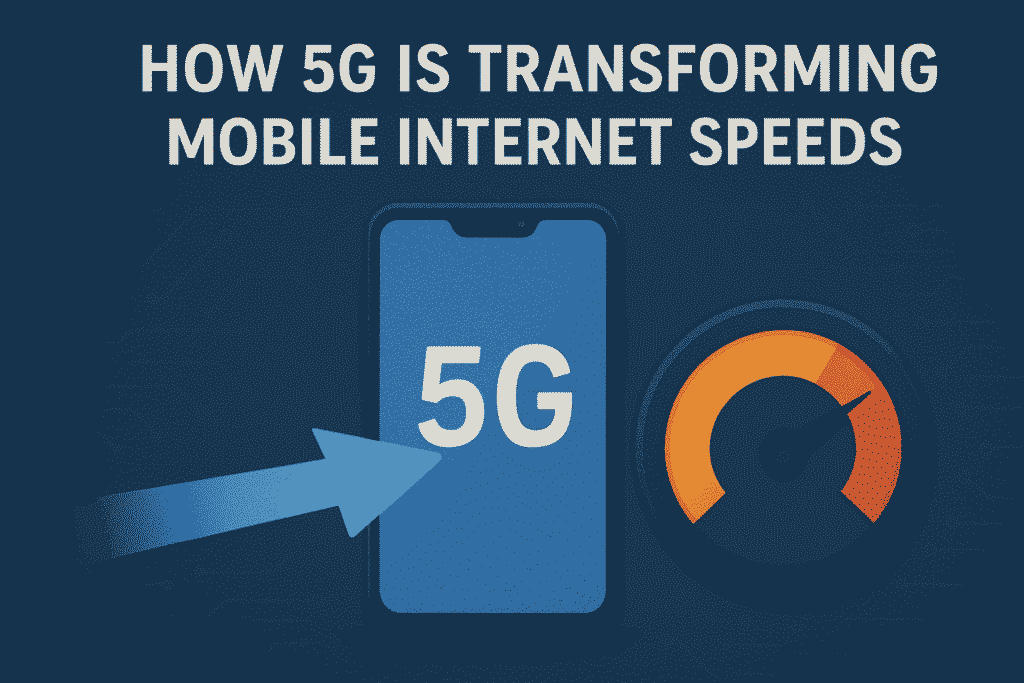
Table of Contents
Introduction: The Leap into the 5G Era
Imagine downloading a full-length, high-definition movie in the time it takes to read this sentence. Or streaming a live, 360-degree virtual reality concert with zero buffering while riding a high-speed train. These are not scenes from a distant sci-fi future; they are the tangible promises of the fifth generation of wireless technology—5G. For decades, mobile networks have evolved incrementally, each “G” offering a modest step up from the last. But 5G is different. It is not merely an upgrade; it is a fundamental transformation of the very fabric of connectivity, engineered to support a world where everything is online. At the heart of this revolution is a dramatic, order-of-magnitude leap in mobile internet speed that is already beginning to redefine what is possible on a mobile device. This article delves into the engineering marvels, real-world applications, and profound challenges behind how 5G is transforming mobile internet speeds, moving us from a world of connectivity to one of instantaneous immersion.
1. Understanding 5G: More Than Just Speed
While speed is its most headline-grabbing feature, 5G is a multi-faceted technology designed to do three crucial things simultaneously, as defined by international standards bodies like the ITU (International Telecommunication Union):
- eMBB (enhanced Mobile Broadband): This is the facet most directly experienced by consumers. eMBB is all about delivering significantly faster data rates, higher network capacity, and a more consistent user experience in high-density areas. It enables the 4K video streaming, immersive AR/VR, and lightning-fast downloads that capture the public’s imagination.
- uRLLC (ultra-Reliable Low Latency Communications): This is about critical response times. Latency, the delay before a transfer of data begins, is slashed in 5G to as low as 1 millisecond. This is essential for applications where a split-second delay can have serious consequences, such as remote surgery, autonomous vehicle coordination, and industrial automation.
- mMTC (massive Machine Type Communications): This pillar focuses on connecting a vast number of devices—potentially millions per square kilometer—with minimal power consumption. This is the backbone of the Internet of Things (IoT), enabling smart cities, connected sensors, and wearable technology to all function seamlessly on a single network.
While uRLLC and mMTC will enable transformative new industries, it is the eMBB component that is most directly and immediately revolutionizing the speed of mobile internet for the average user, creating a foundation upon which other applications can be built.
2. Key Technologies Powering the 5G Speed Boost
The staggering speed improvements of 5G are not the result of a single breakthrough but a symphony of advanced technologies working in concert.
Millimeter Waves (mmWave): Traditional cellular networks operate on crowded radio waves below 6 GHz. 5G introduces the use of much higher frequency bands, known as millimeter waves (mmWave), which range from 24 GHz to 100 GHz. These high-frequency waves have much shorter wavelengths and can carry a colossal amount of data, akin to switching from a narrow garden hose to a wide firehose. However, this comes with a trade-off: mmWave signals have limited range and are easily obstructed by walls, windows, and even rain. This necessitates a dense network of small cells to ensure coverage.
Massive MIMO (Multiple Input Multiple Output): 4G base stations might have a dozen ports for antennas. 5G base stations, equipped with Massive MIMO, can feature hundreds of tiny antennas arrayed together. This allows the tower to send and receive signals from many more users simultaneously. Think of it like a teacher addressing an entire classroom (4G) versus a teacher having a one-on-one conversation with every single student at the same time without raising their voice (5G Massive MIMO). This dramatically increases the capacity and overall speed of the network in crowded areas like stadiums and urban centers.
Beamforming: This intelligent technology works hand-in-hand with Massive MIMO. Instead of broadcasting signals in all directions like a lighthouse, a 5G tower using beamforming precisely directs a focused stream of data directly to a specific user’s device. This targeted approach makes transmission more efficient, reduces interference for other users, and extends the range of higher-frequency signals. It effectively ensures that the maximum possible speed is delivered where it’s needed most.
Network Slicing: This is a revolutionary architectural concept unique to 5G. It allows network operators to create multiple virtual, independent networks on top of a single physical infrastructure. Each “slice” can be customized for a specific purpose. For instance, an operator could create one slice optimized for ultra-high-speed smartphone users, another for ultra-reliable low-latency communications for a factory, and a third for massive IoT sensor networks. This ensures that a bandwidth-intensive application like cloud gaming doesn’t get bogged down by thousands of IoT devices, guaranteeing consistent high speeds for each service.
Edge Computing: While not a radio technology itself, edge computing is a critical enabler for 5G’s low-latency promise. Instead of sending data hundreds of miles to a centralized cloud server for processing, edge computing places smaller data centers much closer to the user, at the “edge” of the network. For tasks requiring instant response—like a VR headset rendering a new scene or an autonomous car detecting an obstacle—this drastically reduces the round-trip time for data, making the high speeds feel truly instantaneous.
3. The Infrastructure Behind the Speed: A Network Reborn
Delivering these blistering speeds requires a complete overhaul of traditional cellular infrastructure.
The 5G Core Network: 5G introduces a new, cloud-native core network. Unlike the hardware-dependent cores of the past, the 5G core is based on software-defined networking (SDN) and network function virtualization (NFV). This makes the network more flexible, scalable, and agile, allowing for features like network slicing and much more efficient traffic management, which is essential for maintaining high speeds under heavy load.
The Critical Role of Fiber Optics: A 5G tower, especially one handling mmWave traffic, generates a massive amount of data that needs to be transported to the core network. This requires a high-capacity “backhaul” connection. Fiber optic cables, with their virtually unlimited data capacity, are the only technology capable of supporting this backhaul demand. In many ways, the speed of 5G is built on the foundation of a nation’s fiber infrastructure.
Small Cells and Macro Towers: The limited range of high-band spectrum means that large, powerful cell towers (macro cells) are no longer sufficient. To provide blanket coverage, especially indoors and in urban canyons, carriers must deploy a dense network of low-power “small cells.” These are miniature base stations, often mounted on lampposts, building sides, and inside venues. This hyper-dense network is crucial for delivering the consistent, multi-gigabit speeds that 5G promises.
4. Real-World Speed Experiences and Metrics
The theoretical peak speed of 5G is a staggering 20 Gbps. In the real world, users will never experience this—it’s a laboratory ideal shared across an entire cell sector. However, real-world speeds are still transformative.
On sub-6 GHz networks (the foundation for wide-area coverage), users can consistently expect download speeds between 100 Mbps and 900 Mbps, with latency often below 30ms. This is a 4-10x improvement over typical 4G LTE performance. On mmWave networks in optimal conditions (open air, close to a node), speeds can regularly eclipse 1.5 Gbps and even approach 3 Gbps, with latency dropping to single digits. This means a 1 GB video game update that took nearly 5 minutes on a good 4G connection can now download in under 10 seconds.
Global speed test data from firms like Ookla consistently shows countries with advanced 5G deployments, such as South Korea, the UAE, and parts of the United States, recording median download speeds that are orders of magnitude faster than their 4G counterparts.
5. Beyond Smartphones: How 5G Speed Transforms Industries
The impact of 5G speed extends far beyond faster social media feeds on smartphones.
- Enhanced Mobile Broadband: Consumers will experience seamless 4K/8K video streaming, immersive cloud gaming that feels local (services like Xbox Cloud Gaming and NVIDIA GeForce NOW), and rich social VR/AR experiences without the nausea-inducing lag of previous generations.
- Industrial Automation: Factories can use high-speed, low-latency 5G to wirelessly connect robots and sensors, enabling them to coordinate in real-time for complex assembly tasks and adaptive manufacturing processes.
- Autonomous Vehicles: Self-driving cars require a constant stream of data from their sensors and from other vehicles (V2V) and infrastructure (V2I). 5G’s speed and ultra-low latency allow cars to “see” around corners and react to hazards instantly, making autonomy safer and more efficient.
- Healthcare: Telesurgery becomes a viable reality. A specialist surgeon could operate remotely on a patient using robotic tools, with the 5G network ensuring their movements are executed with zero perceptible delay, making procedures safe and precise.
- Smart Cities: Municipalities can deploy vast networks of high-resolution sensors to monitor traffic flow, air quality, and energy usage in real-time, enabling dynamic management of city resources and services.
6. Challenges in Delivering Consistently High Speeds
The path to universal gigabit-speed mobile internet is fraught with challenges.
- Coverage Limitations: Building a dense network of small cells is incredibly expensive and logistically complex, involving permits and negotiations with countless municipalities and property owners. This means ubiquitous mmWave-level speeds will likely be confined to dense urban cores, airports, and stadiums for the foreseeable future.
- Spectrum Availability: Carriers must balance different spectrum bands. Low-band spectrum offers wide coverage but slower speeds, while high-band offers incredible speed but poor coverage. Mid-band spectrum has emerged as the crucial “goldilocks” band, offering a good blend of both, but it is a finite and highly sought-after resource.
- Device Compatibility: To access these new speeds, consumers must have 5G-enabled devices with modems capable of connecting to the various spectrum bands. Early adoption barriers are slowing down, but device penetration is still a factor.
- Network Congestion: While 5G is designed to handle more devices, the laws of physics still apply. In a densely populated area with thousands of users on a single cell, available bandwidth is still shared, and speeds can drop during peak usage times.
7. The Future of 5G Speed: What’s Next?
The evolution of 5G is ongoing. Standards bodies are already working on future “releases” (e.g., 5G-Advanced) that will further enhance performance. We can expect to see:
- AI-Driven Network Optimization: Using artificial intelligence and machine learning to dynamically manage network traffic, predict congestion, and allocate resources instantly to where speed is needed most.
- Advanced Antenna Technology: Further refinements in Massive MIMO and beamforming will continue to push the boundaries of spectral efficiency and data throughput.
- Integration with Satellite and Terrestrial Networks: The emergence of Low Earth Orbit (LEO) satellite constellations (like Starlink) is exploring integration with 5G to provide seamless coverage and high-speed connectivity in remote and rural areas, filling in the gaps left by terrestrial networks.
- The Path to 6G: Even as 5G rolls out, research into 6G has already begun. Expected around 2030, 6G promises to leverage even higher terahertz (THz) frequencies and integrate AI at its core, potentially offering peak speeds of 1 Terabit per second (Tbps)—ushering in capabilities we can scarcely imagine today.
Conclusion: The Speed Revolution is Just Beginning
The transformation of mobile internet speeds by 5G is a profound technological shift. It is a feat of human ingenuity, combining breakthroughs in radio engineering, network architecture, and computing. While the journey to universal, multi-gigabit connectivity is complex and uneven, the direction is clear. The initial wave of faster downloads and smoother streaming is merely the tip of the iceberg. The true revolution lies in how this foundational layer of speed and responsiveness will enable entirely new industries, redefine how we work and play, and ultimately reshape our interaction with the digital world. The 5G era has begun, and it is moving at an exhilarating pace.
